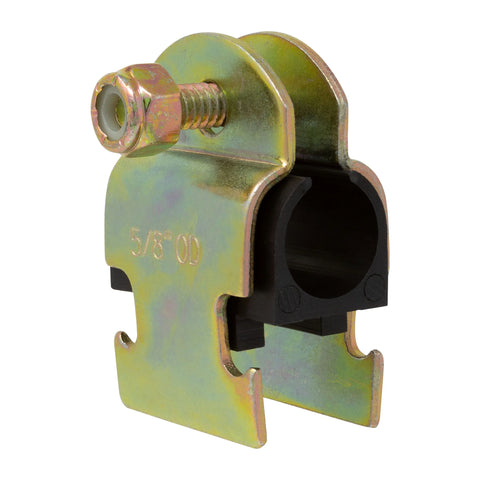A Complete Guide on Cushion Clamps - Pipe Management Made Easy
In the world of industrial engineering and water supply systems, where precision, efficiency, and reliability reign supreme, it's often the small details that make the biggest difference. Among the various accessories that go into these systems are cushion clamps – unassuming devices that play a crucial role in cable management, organization, and protection.
In this article, we'll dive into the world of cushion clamps, exploring their significance, applications, and why they're important for various industries.
Understanding Cushion Clamps
Clamps, in general, are devices used to hold objects in place. Cushion clamps, also known as loop clamps or cushioned clamps, are simple yet smart devices designed to secure and organize hoses, cables, pipes, or tubes in a wide array of applications. Their cushioned lining, typically made of rubber or other resilient materials, sets them apart. This lining serves multiple purposes, including reducing vibration, preventing abrasion, and providing a secure grip on the item being clamped.
What Does a Cushion Clamp Consist Of?
At first glance, a cushion clamp may seem like a simple component – a metal or plastic clamp with a cushioned lining. However, a closer look reveals a well-thought-out design optimized for efficiency and durability.
- Clamping Mechanism: The core of the cushion clamp is its clamping mechanism, which secures the object in place. This mechanism may consist of a single clamp or multiple clamps, depending on the design and application requirements.
- Cushioned Lining: Surrounding the clamping mechanism is the cushioned lining, often made of rubber material. This lining provides a soft, protective barrier between the clamp and the object, minimizing the risk of damage from vibration, friction, or movement.
- Mounting Holes: Most cushion clamps feature mounting holes for easy installation on surfaces such as walls, panels, or frames. These holes allow for secure attachment using screws, bolts, or other fasteners, ensuring stability and reliability in operation.
Applications of Cushion Clamps
Cushion clamps find widespread use across various industries and applications, thanks to their versatility, reliability, and effectiveness. Some common applications include:
- Automotive: In the automotive industry, cushion clamps are indispensable for securing wiring harnesses, brake lines, fuel hoses, and other critical components. They help prevent chafing, vibration-induced wear, and potential electrical or fluid leaks, ensuring optimal performance and safety.
- Aerospace: In aerospace applications, where precision and reliability are paramount, cushion clamps play a crucial role in securing cables, tubing, and hydraulic lines in aircraft and spacecraft. Their ability to withstand extreme conditions and maintain integrity under high levels of vibration and stress makes them essential for mission success.
- Industrial Machinery: Across various industrial sectors, from manufacturing plants to processing facilities, cushion clamps are used to organize and secure hoses, pipes, and cables in machinery and equipment. Minimizing movement and vibration, they help prolong the lifespan of components and reduce maintenance costs.
- Piping Installations: Cushion clamps come in handy when you are installing PVC pipes, PEX pipes, or copper pipes in homes and buildings for water supply and water filters.
Advantages of Using Cushion Clamps
The widespread adoption of cushion clamps can be attributed to several key advantages they offer:
- Vibration Dampening: By providing a cushioned barrier between the clamp and the object, cushion clamps effectively reduce vibration, reducing noise and minimizing wear and tear on components.
- Protection Against Abrasion: The soft, resilient lining of cushion clamps helps protect hoses, cables, and other objects from abrasion caused by friction or movement, extending their lifespan and reliability.
- Secure Mounting: With their mounting holes and compatibility with various fasteners, cushion clamps offer a secure and stable mounting solution, ensuring that components remain in place even under tough conditions.
- Versatility: Available in a wide range of sizes, materials, and configurations, cushion clamps can accommodate diverse applications and requirements, making them a versatile choice for engineers and plumbers.
There’s also a special type of cushioning that has a hard rubber attached. This rubber cushion protects pipes and tubes by absorbing shocks caused by vibration and temperature changes, reduces unwanted noise, insulates pipes from metal surfaces, and prevents galvanic corrosion.
Rubber cushion clamps come in various sizes including ⅝” (supports ½” NOM pipes), ⅞” (supports ¾” NOM pipes), and 1-⅛” (supports 1” NOM pipes). These rubber cushion clamps can support copper, PEX, and CPVC pipe types.
Conclusion
In the web of various pipes and tubes, where every component plays a crucial role, cushion clamps are indispensable friends in cable management, organization, and protection.
With their ability to dampen vibration, prevent abrasion, and provide secure mounting, these little devices quietly uphold the integrity and reliability of countless industrial applications.
We hope this article helped you understand all there is to know about cushion clamps.
For more informative blogs, keep following the Metpure blog.










